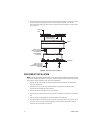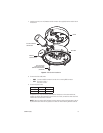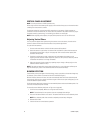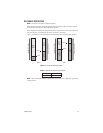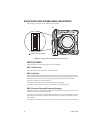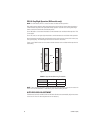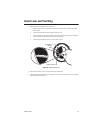22 C3426M-A (5/07)
VERTICAL PHASE ADJUSTMENT
NOTE:
Use this procedure for 24 VAC operation only.
When using more than one camera power supply, a brief vertical roll may occur on the monitor when
switching from one camera to another.
To eliminate vertical roll, reverse the 24 VAC connections on one camera. If both cameras are
connected to the same transformer, this should solve the problem. If the problem still exists, adjust
the phase control by synchronizing, or line-locking, the cameras to one another.
NOTE:
When adjusting vertical phase, line sync (SW4-3) must be set to OFF for AC line lock.
Adjusting Vertical Phase
You may need two people when synchronizing the cameras: one at the camera, the other at the
monitor to observe the vertical roll and the effect of any camera adjustments.
To synchronize the cameras:
1. Choose a reference camera to which all other cameras will be phased.
2. Select the camera to synchronize. Use buttons SW1 and SW2 to synchronize the camera to
the reference camera (refer to Figure 10 on page 20). SW1 increases vertical phase; SW2
decreases vertical phase.
3. Each time an adjustment is made, switch back and forth between the camera you are
adjusting and the reference camera. Repeat this process as many times as necessary until the
roll between the cameras is no longer noticeable.
4. Adjust the phase of all other cameras by repeating steps 2 through 3. Always adjust to the
reference camera selected in step 1.
NOTE:
The preferred method for camera phase adjustment is to use a dual trace oscilloscope to
align the vertical sync pulses of the reference camera to the selected camera(s).
BLEMISH DETECTION
If small white or color spots appear in the video image, one or more pixels on the camera imager may
be defective. (This condition is common for both CCD and CMOS imagers.)
DN and CH Series cameras with auto iris lenses automatically detect and correct defective pixels
during startup. Video turns on, then off, and then on again. If white or color spots still appear, you can
correct the defective pixels manually.
CH Series cameras with fixed iris lenses do not automatically detect and correct defective pixels. You
can correct the defective pixels manually.
To manually correct defective pixels (refer to Figure 10 on page 20):
1. Cover the lens completely. Make sure no light can enter the lens.
NOTE:
The mechanical iris lens aperture does not completely block the light.
2. Press and hold button SW3 for one second. The camera will find and correct defective pixels.
NOTE:
Any defective pixels that cannot be completely corrected may still appear.
3. Release button SW3.
4. Uncover the lens for normal camera operation.



